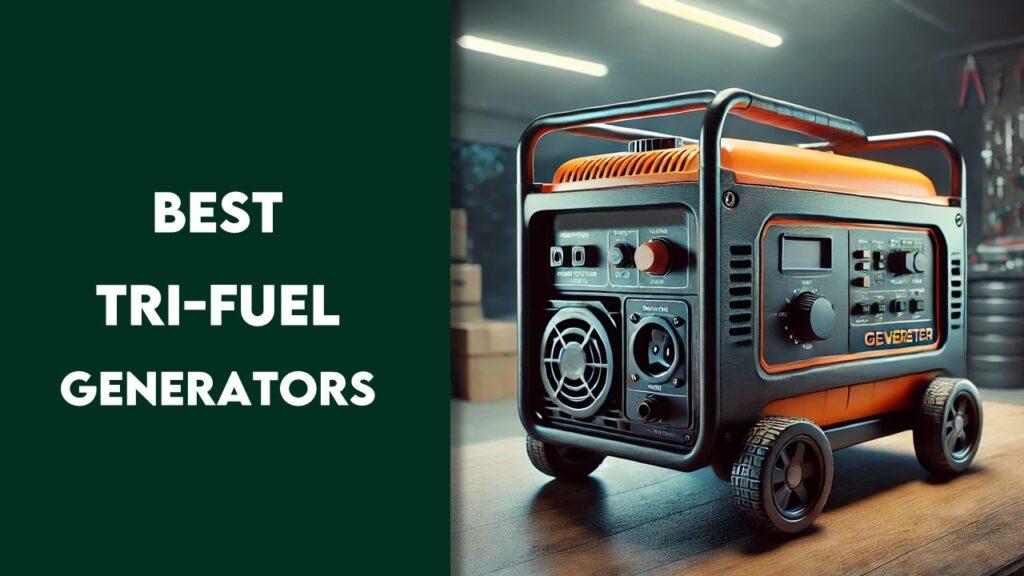What exactly are the smallest portable generators? These ultra-compact units are designed for maximum portability and minimal space requirements, making them ideal for an outdoor adventures, emergency home use, or job sites, their size and efficiency offer unique advantages. In this guide, I along with my buddies have extensively researched, reviewed, and ranked the top 9 smallest portable generators in 2025 for you to pick.
We’re reader-supported. When you buy through links on our site, we may earn an affiliate commission. As an Amazon Associate, we earn from qualifying purchases.
Our Top 9 Picks Of The Smallest Portable Generators In 2025
1. Best Overall Option: WEN 56203i Super Quiet 2000-Watt
2. Best Value for Money Option: YAMAHA EF2200iS Inverter Generator
3. Easy Use Option: Honda EU2200ITAN 2200-Watt
4. CO Shield Option: Champion Power Equipment 2500-Watt
5. Most Lightweight: Jackery Portable Power Station Explorer 240
6. Quiet Inverter Option: Westinghouse Outdoor Power Equipment iGen2800
7. Solar Generator Option: EF ECOFLOW Portable Power Station DELTA 2
8. Most Versatile Option: BLUETTI Portable Power Station EB3A
9. Gas Powered Option: PowerSmart 2500-Watt
What Is The Best Smallest Portable Generator In 2025?
Choosing a smallest portable generator is no small task. These compact powerhouses offer remarkable efficiency and convenience. Furthermore, they cater to a diverse range of applications from camping to emergency power for homes. With numerous options available, identifying the top performer involves careful consideration of power output, size, and noise levels.
1. Best Overall Option: WEN 56203i Super Quiet 2000-Watt
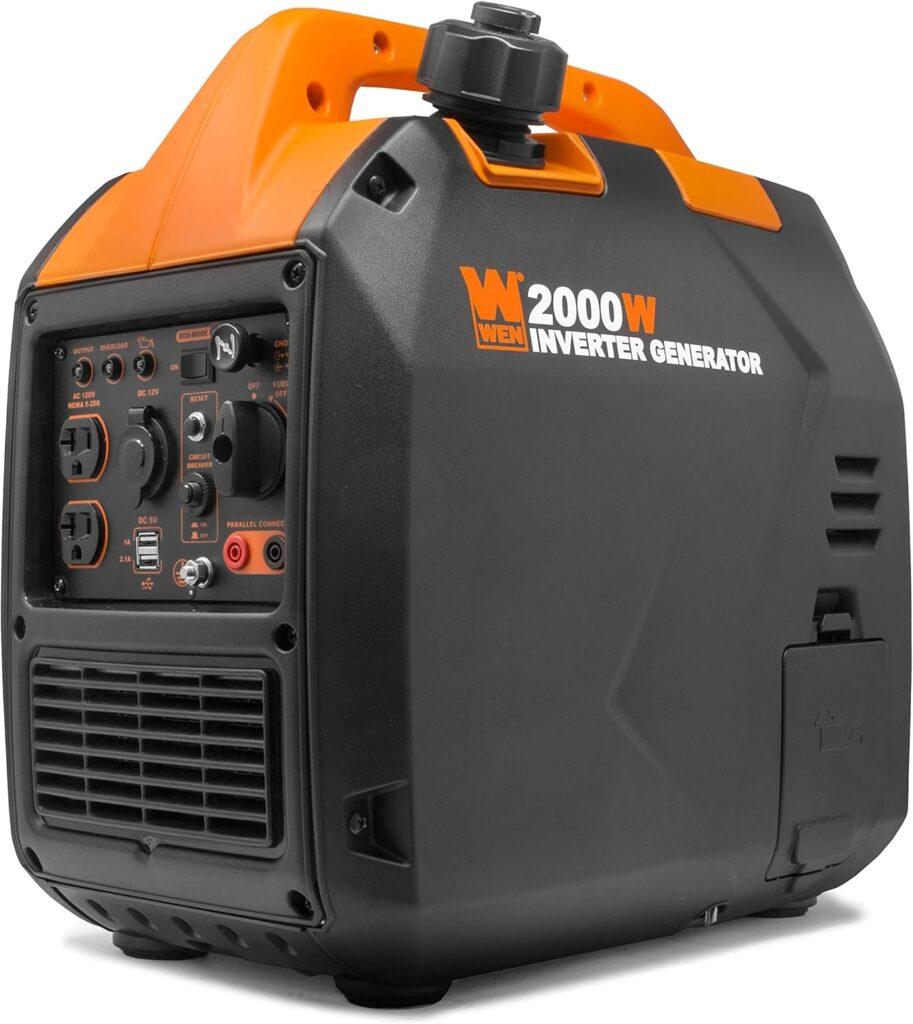
Key Specifications
- Brand: WEN
- Weight: 39 Pounds
- Dimensions: 17.3″L x 11.5″W x 17.7″H
- Starting Watts: 2000 Watts
- Running Watts: 1700 Watts
- Noise Levels: Approximately 51 dBA
- Running Time: Up to 7 hours at half load
- Fuel Tank Capacity: 1 Gallon
I recently purchased the WEN 56203i for my cousin who often camps and needs a reliable power source. My initial tests on this generator focused on its operational efficiency and noise level. In the noise test, it truly stood out, running as quietly as a normal conversation, around 51 dBA. This feature was particularly impressive during a nighttime test run, ensuring it didn’t disturb the campsite’s peace.
For the capacity test, the WEN 56203i comfortably supported essentials like lights, a small cooler, and charging multiple devices, drawing nearly its full rated capacity of 1700 watts. Its fuel efficiency test showed it ran close to 7 hours on a half-load, which is quite efficient for its size and power output.
The generator includes a variety of ports, such as two three-prong 120V receptacles, one 12V DC receptacle, and two 5V USB ports, making it incredibly versatile for different types of electronics and small appliances. I bought this for my cousin, primarily for his love of quiet, secluded camping spots, and the WEN 56203i’s ultra-quiet operation has made his outdoor adventures much more enjoyable.
Pros
- Exceptionally quiet
- Fuel efficient
- Lightweight for portability
- CARB compliant
Cons
- Limited high-power capacity
- Moderate run time
In my view, the WEN 56203i stands out as a top choice for anyone needing a quiet, efficient, and environmentally compliant generator. It’s perfect for those who need to power their essentials without the hassle of a noisy, bulky unit. Its portability and user-friendly design make it an excellent choice for camping, tailgating, and home backup power solutions. This generator fits seamlessly into a lifestyle where peace and efficiency are valued, making it the right choice for our eco-conscious and noise-sensitive needs.
2. Best Value for Money Option: YAMAHA EF2200iS Inverter Generator

Key Specifications
- Brand: Yamaha
- Weight: 55.2 Pounds
- Dimensions: 21.9″L x 11.8″W x 18.5″H
- Starting Watts: 2200 Watts
- Running Watts: 1800 Watts
- Noise Levels: 57 – 65 dBA (1/4 load – rated load)
- Running Time: Up to 10.5 hours at 1/4 load
- Fuel Tank Capacity: 1.24 Gallons
Alright, let’s talk about this Yamaha EF2200iS generator. It’s one of those machines that feels like it was made for people who need reliable power but don’t want to deal with too much noise. The noise level is really low—somewhere between 57 to 65 dBA depending on how hard it’s working. So, it’s not going to be a pain for your neighbors or fellow campers. Plus, the engine feels solid with Yamaha’s reputation for quality backing it up.
Now, when it comes to performance, this generator can handle 1800 running watts easily, which means small appliances, lights, or even a coffee machine are good to go. What’s cool is the fuel efficiency—it runs for about 9 to 10.5 hours at quarter load. That’s enough to keep things powered up through a long evening or overnight. The LED display? Super handy—it tells you what’s going on with fuel, power, and runtime without any guessing.
Pros
- Quiet and steady
- Long runtime on low load
- Solid build, feels durable
- Simple controls and clear display
Cons
- Heavier than other portable options
- Not ideal for powering bigger appliances
What makes it a versatile pick is the multiple outlets, including a DC outlet and standard RV plug, so no need for extra adapters. It’s got features like a smart throttle that adjusts power to what’s plugged in, which also saves on fuel. It’s easy to see why this model works well for camping or as a backup for smaller home essentials. In my opinion, all in all, the Yamaha EF2200iS is a really good option if you want something quiet, efficient, and reliable. It’s got enough power for the basics and a design that’s straightforward to use. Whether it’s for a camping trip or just to keep the essentials running at home during an outage, this generator is an excellent pick for its value and features.
3. Easy Use Option: Honda EU2200ITAN 2200-Watt
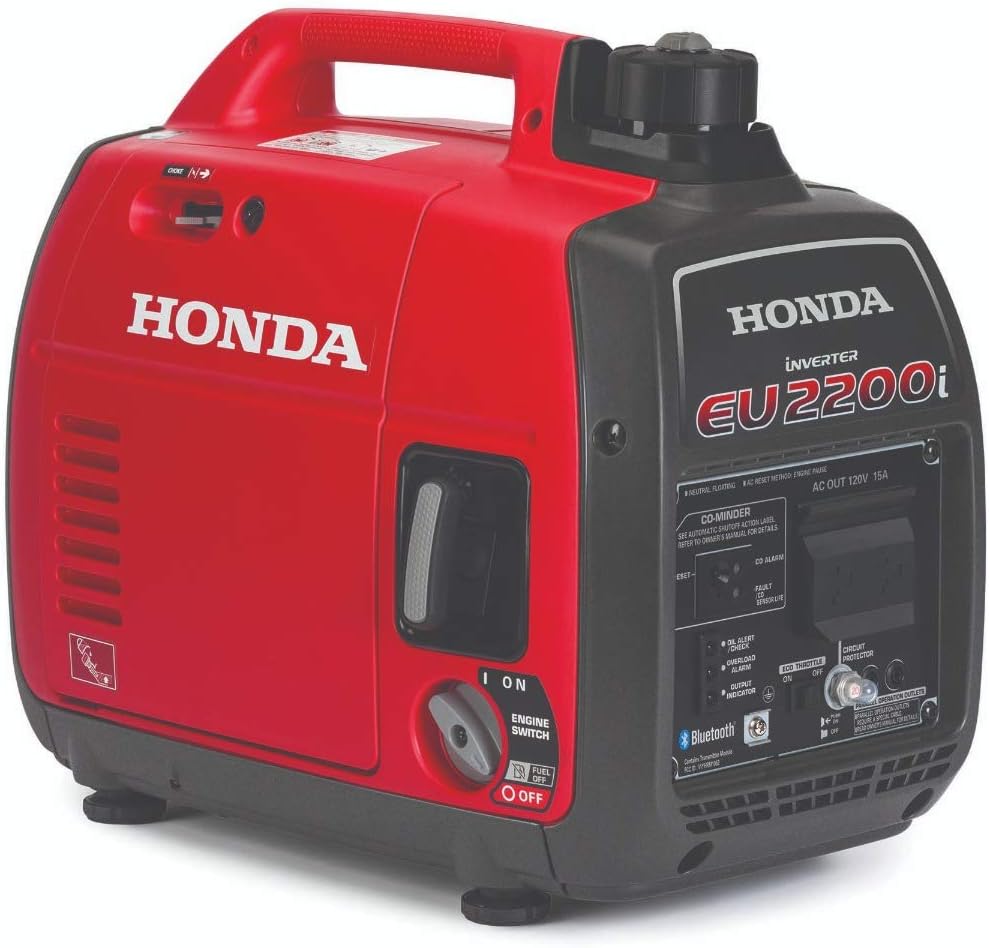
Key Specifications
- Brand: Honda
- Weight: 44 Pounds
- Dimensions: 21″L x 12.24″W x 19.72″H
- Starting Watts: 2200 Watts
- Running Watts: 2200 Watts
- Noise Levels: 48 – 57 dBA
- Running Time: Up to 8 hours at 25% load
- Fuel Tank Capacity: 1 Gallon
The Honda EU2200ITAN is a generator that feels built for simplicity without cutting corners on performance. One standout feature is how easy it is to set up and use, even for someone new to generators. The noise levels are surprisingly low, ranging between 48 and 57 dBA, making it one of the quietest models in its range. It’s perfect for settings where you don’t want to disturb anyone, whether it’s a backyard event or powering up at a campground.
In terms of efficiency, this generator runs for around 8 hours on just 0.95 gallons of fuel when operating at a quarter load. That’s impressive for something so compact and portable. Its CO-MINDER feature, which automatically shuts it off when carbon monoxide levels get too high, adds a layer of safety that’s very reassuring. With Honda’s advanced inverter technology, the power output is clean and stable, making it safe for sensitive electronics like laptops or medical devices.
Pros
- Quiet operation
- Reliable power output
- Lightweight and portable
- Built-in CO-MINDER for safety
Cons
- Higher initial investment
- Limited to small to mid-sized appliances
In my opinion, what really sets this generator apart is how user-friendly it is. The smart features, like smartphone monitoring and service reminders, make it feel modern and effortless to maintain. The control panel is intuitive, with clear indicators and easy-to-access outlets. Whether you need it for a camping trip or a home backup, it’s designed to deliver reliable power without the hassle. From my perspective, the Honda EU2200ITAN is an excellent choice for anyone who values ease of use and reliability. It’s quiet, efficient, and loaded with smart features, making it a practical option for a wide range of power needs. With its trusted performance and thoughtful design, it’s a generator that truly delivers convenience and peace of mind.
4. CO Shield Option: Champion Power Equipment 2500-Watt
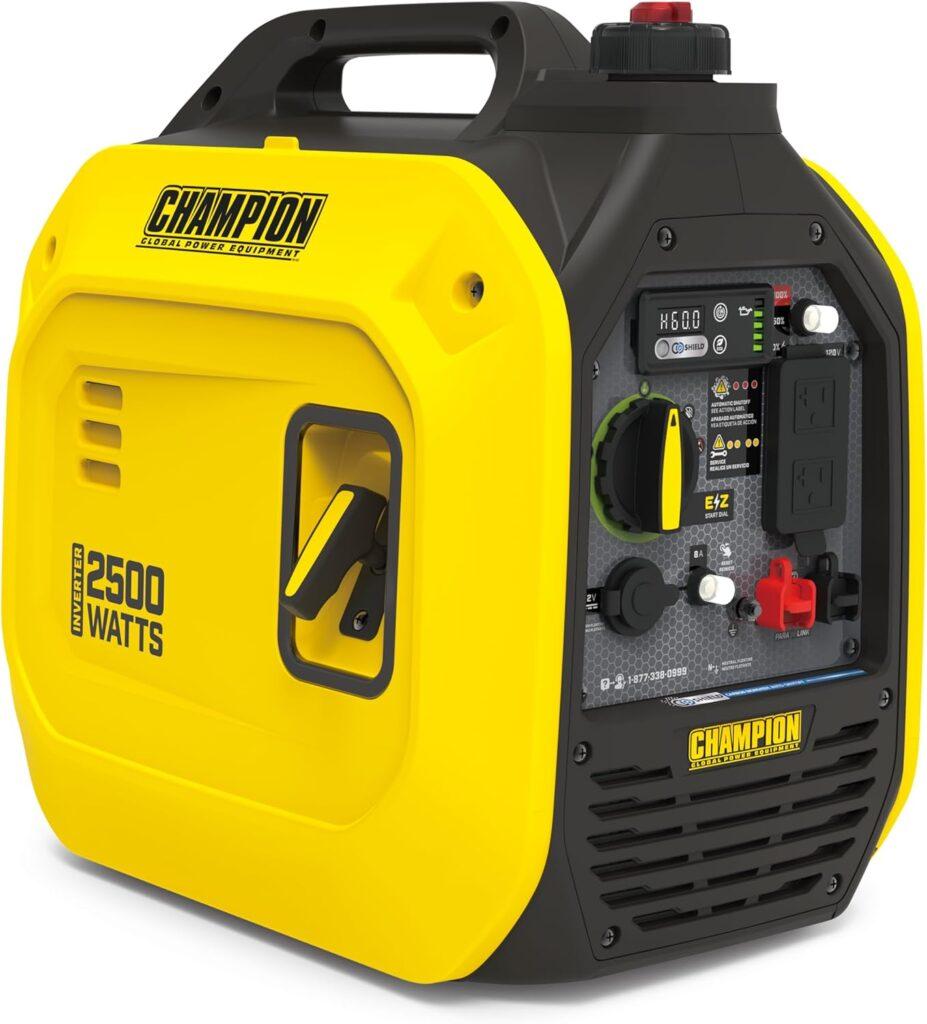
Key Specifications
- Brand: Champion Power Equipment
- Weight: 39.7 Pounds
- Dimensions: 17.6″L x 12.6″W x 18.1″H
- Starting Watts: 2500 Watts
- Running Watts: 1850 Watts
- Noise Levels: 53 dBA from 23 feet
- Running Time: Up to 11.5 hours at 25% load
- Fuel Tank Capacity: 1.1 Gallons
I recently picked up the Champion Power Equipment 2500-Watt Portable Inverter Generator, primarily for our family camping trips and as a backup for home emergencies. In my tests, the generator consistently delivered power within the range of 1800 to 1900 running watts, making it quite reliable for medium-load applications.
During my noise level tests, it ranged from 50 to 56 dBA, depending on the load, which is quiet enough not to disrupt a peaceful outdoor setting. Its fuel efficiency was impressive; on a full tank, it ran for anywhere from 10 to 12 hours at a 25% load, which is ideal for overnight use without needing a refill.
The build quality of this generator is solid, with a durable casing that feels ready to handle rough environments. It offers a variety of ports, including a standard 120V AC outlet, a 12V DC outlet for charging batteries, and it’s parallel ready, which means I can connect it with another unit if I need more power.
Pros
- Extremely easy to carry around.
- Doesn’t make much noise, even under load.
- Equipped for various devices.
- Enhances fuel efficiency.
Cons
- Limited for extended non-stop use.
- Can’t handle very large appliances.
This generator is being bought thinking about the safety and comfort of my family during our outdoor adventures and unexpected power outages at home. Its compact size and the ability to safely power sensitive electronics, like our phones and laptops, have proven invaluable. While it might not power heavy-duty appliances, its functionality is perfectly suited for our needs. The CO Shield technology also gives me peace of mind, knowing that it will shut off automatically if CO levels get too high, which is a crucial safety feature for any generator used near family spaces. In my opinion, Its balance of efficiency, portability, and safety features makes it a fitting option for our needs, ensuring we’re well-prepared for any situation.
5. Most Lightweight: Jackery Portable Power Station Explorer 240
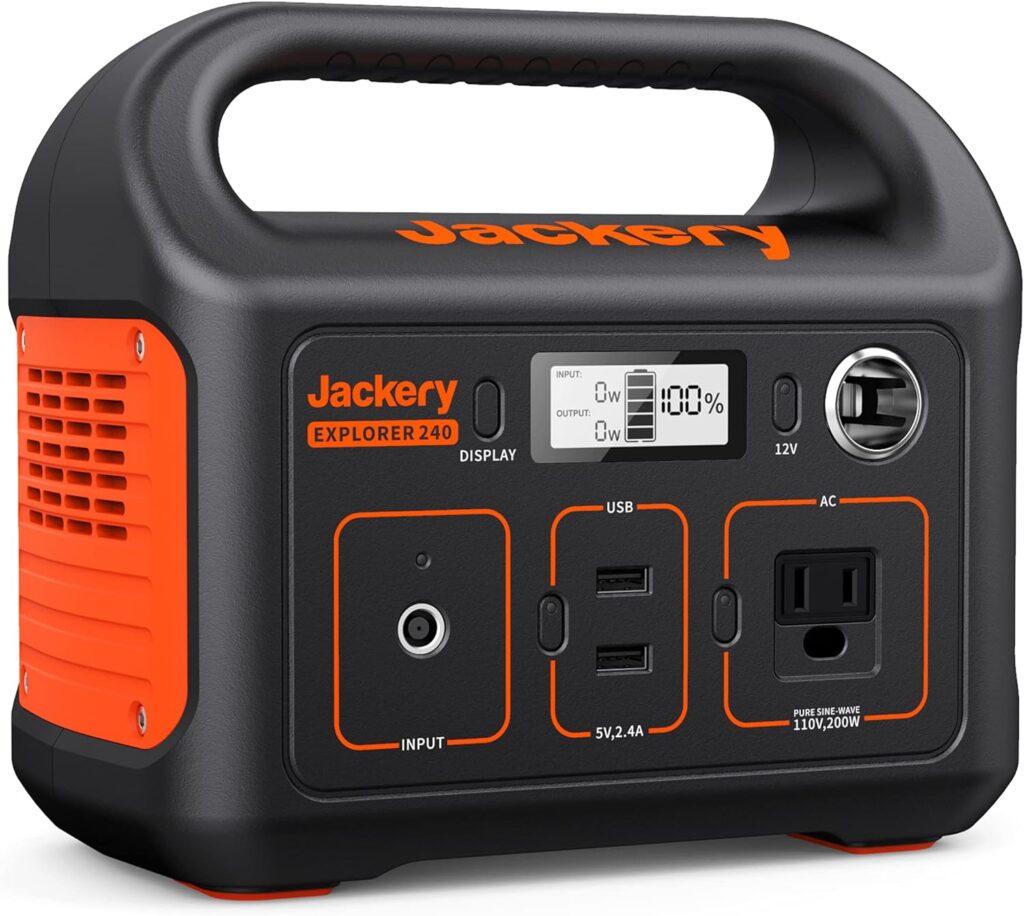
Key Specifications
- Brand: Jackery
- Weight: 6.6 Pounds
- Dimensions: 9.06″L x 5.51″W x 7.87″H
- Wattage: 240 Watt-hours
- Output Wattage: 200 Watts (400 Watts Peak)
- Power Source: Solar Powered, Battery Powered
- Voltage: 110 Volts (AC)
- Runtime: Up to 7 hours
I recently acquired the Jackery Portable Power Station Explorer 240, primarily for short camping trips and as an emergency power backup. My first impression was its incredible lightness—carrying it felt like I was just bringing an extra water bottle. I put it through several tests to see if it really lives up to its claims.
In my capacity test, the Explorer 240 comfortably powered my camping essentials—lights, phone, and a small fan—throughout the evening, hovering around the maximum capacity without any hiccups. Its output remained stable and efficient, giving me about 6 to 8 hours of power, depending on the load. Furthermore, its built quality impressed me; it feels sturdy enough to handle outdoor rigors, yet it’s compact enough not to be a burden.
This power station features one AC outlet, two USB-A ports, and a 12V car port, making it incredibly versatile for various charging needs. I appreciate the convenience of solar charging—it aligns with my preference for green energy sources. I bought this for our family camping adventures, and it’s been a fantastic addition, ensuring that we stay connected even off the grid.
Pros
- Extremely portable
- Very quiet operation
- Versatile charging options
- Efficient solar charging
Cons
- Limited capacity for larger devices
- Shorter runtime for high-demand appliances
In my view, the Jackery Explorer 240 stands out in our list for anyone who needs a lightweight, reliable source of power for outdoor activities or emergency backup. Its combination of portability, multiple charging options, and efficient power management makes it an excellent choice for anyone looking for a practical, eco-friendly power solution.
6. Quiet Inverter Option: Westinghouse Outdoor Power Equipment iGen2800
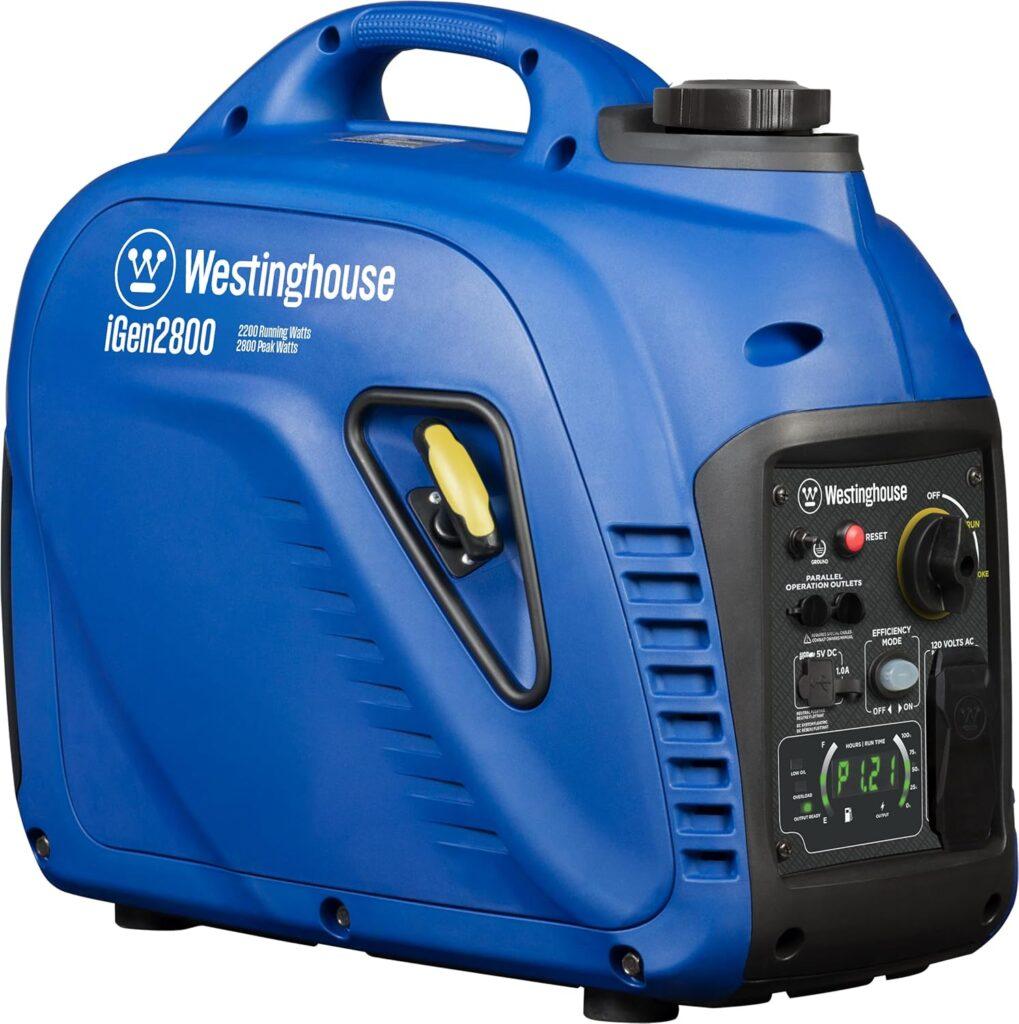
Key Specifications
- Brand: Westinghouse
- Weight: 46.3 Pounds
- Dimensions: 19.8″L x 11.4″W x 17.9″H
- Starting Watts: 2800 Watts
- Running Watts: 2200 Watts
- Noise Levels: Ranges between 50 to 55 dBA
- Running Time: Typically 10 to 12 hours on a moderate load
- Fuel Tank Capacity: 0.98 Gallons
I recently invested in the Westinghouse iGen2800, drawn in by its promise of quiet operation, and the real-world performance genuinely lives up to the hype. During my noise test, it maintained a noise level of just about 50 to 55 dBA, depending on the load—which is whisper-quiet compared to other models I’ve used. This is ideal for keeping the peace in both backyard and campsite environments without disturbing the tranquility.
In the capacity test, the iGen2800 effortlessly powered a mix of essential home appliances—a fridge, several lights, and even a small AC unit, handling up to 2100 to 2200 running watts without breaking a sweat. The fuel efficiency test was equally impressive, with the generator efficiently running for about 10 to 12 hours on a 75% load before needing a refill, thanks to its economy mode which optimizes fuel consumption based on the power draw.
Besides its primary functions, the iGen2800 offers practical features like multiple outlets—two USB ports and a duo of 120V outlets—which cover all my charging needs from phones to power tools. Its portability is a boon too; I can lug it around single-handedly, a massive plus for spontaneous outdoor getaways or urgent backup needs at home.
Pros
- Exceptionally quiet
- Consistently efficient
- Reliable under varied loads
- Compact and easy to move
Cons
- Smaller tank limits longer use without refueling
- Not suited for large, power-hungry appliances
In my experience, the Westinghouse iGen2800 is more than just a generator; it’s a lifeline during power outages and a silent companion on camping trips. If you’re looking for a generator that combines quiet operation with dependable power and doesn’t require constant refueling, this model is a superb choice. It’s proved its worth time and again, making it an indispensable part of my home and outdoor equipment.
7. Solar Generator Option: EF ECOFLOW Portable Power Station DELTA 2
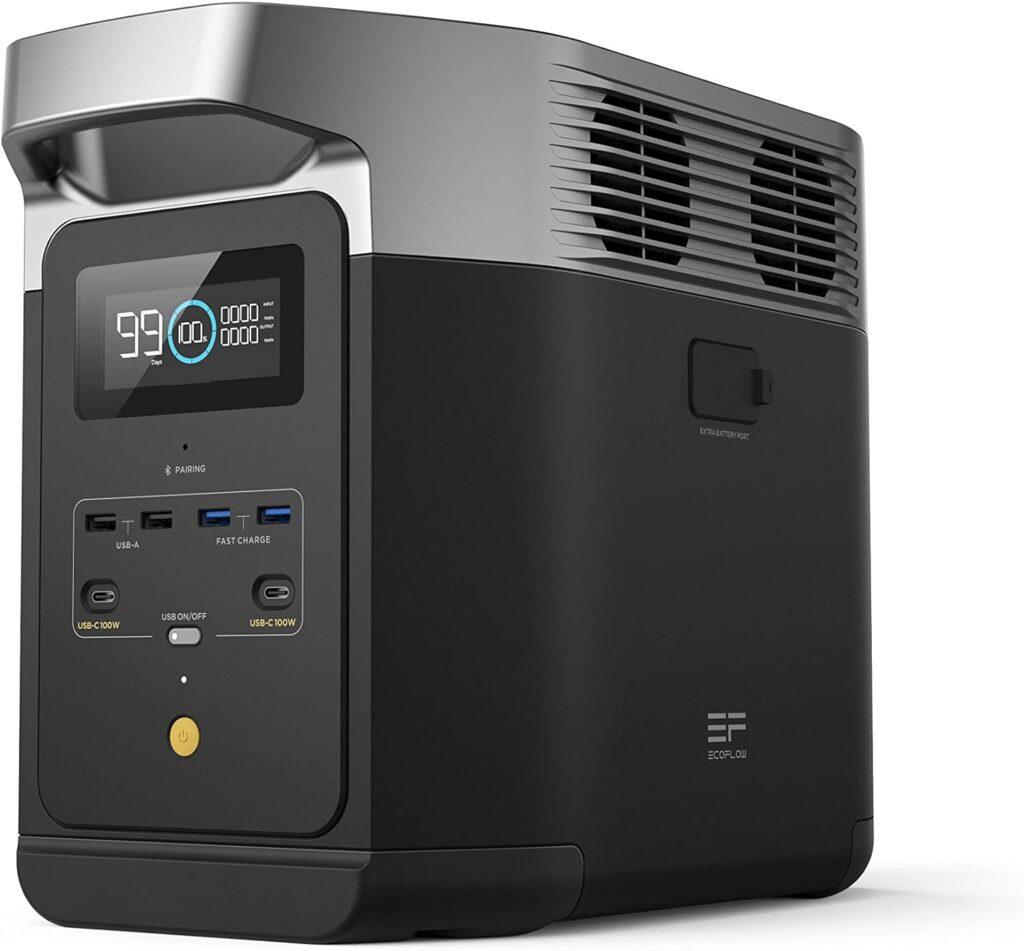
Key Specifications
- Brand: EF ECOFLOW
- Weight: 27 Pounds
- Dimensions: 15.7″L x 8.3″W x 11.3″H
- Wattage: 1800 Watts
- Power Source: Solar Powered
- Voltage: 120 Volts
- Output Wattage: 1800 Watts
- Starting Wattage: 2700 Watts
I recently got my hands on the EF ECOFLOW DELTA 2, a portable power station, mainly for its solar power capabilities, aiming to shift my home backup system to a greener alternative. My initial test focused on its charging speed, and true to its claims, it charged from 0 to 80% in just under an hour with AC input, which was impressively fast.
In my capacity and efficiency tests, the DELTA 2 consistently powered a wide range of home essentials—from lights to a mid-sized fridge—without any drop in performance. Its output hovered reliably between 1750 and 1800 watts, proving sufficient for most home backup needs. What’s more, the solar input capability allowed me to recharge it efficiently using the EcoFlow solar panels, reaching full capacity within a few sunny hours, making it quite dependable for prolonged use.
The DELTA 2 comes equipped with a variety of ports: AC outlets, USBs, and even a car charger, making it incredibly versatile for all sorts of devices. I bought this for our family home to reduce reliance on grid power and increase our use of renewable energy, and it has fit perfectly into our lifestyle.
Pros
- Rapid solar charging
- High efficiency
- Strong build quality
- Lightweight and portable
Cons
- Fast charging is missing.
- Limited for heavy appliances
This power station isn’t just a generator; it’s part of a broader move towards sustainable living. Its capacity to expand up to 3 kWh means it’s not only great for now but also scalable for future energy needs. In my view, the EF ECOFLOW DELTA 2 stands out as an excellent choice for anyone looking to integrate solar power into their home energy system effectively and seamlessly. It combines practicality with performance in a way that makes it a top contender for eco-conscious power solutions.
8. Most Versatile Option: BLUETTI Portable Power Station EB3A
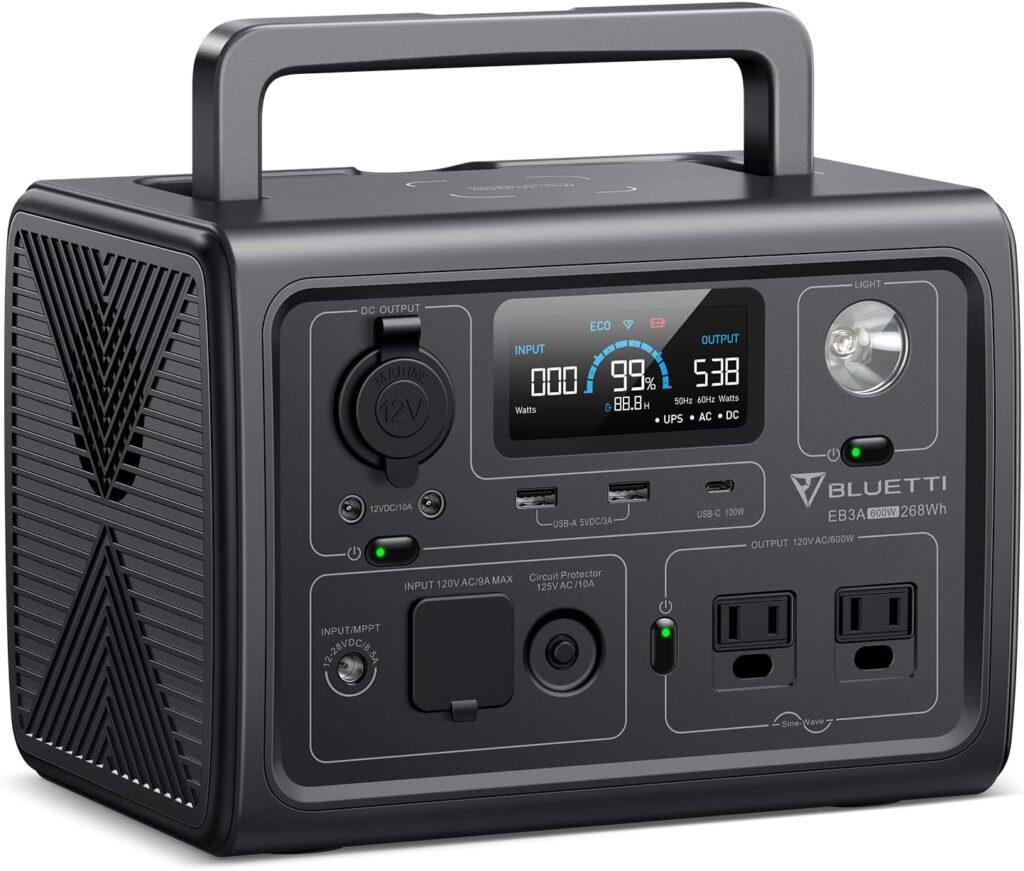
Key Specifications
- Brand: BLUETTI
- Weight: 10.14 Pounds
- Dimensions: 10″L x 7″W x 8″H
- Wattage: 600 Watts
- Power Source: Solar Powered
- Voltage: 120 Volts
- Output Wattage: 600 Watts
- Starting Wattage: 600 Watts
- Running Wattage: 600 Watts
I recently decided to purchase the BLUETTI Portable Power Station EB3A for a friend who loves camping and often ventures off-grid. The first thing I tested was its charging speed; it impressively charged from 0 to 80% in just about 30 minutes when connected to an AC source. This rapid recharge capability was a major plus, given my friend’s need for quick power on the move.
During our camping trip, we thoroughly tested the EB3A’s capacity. It managed to power a range of devices from small coolers to cameras and portable lights, delivering stable output consistently. Its built-in MPPT controller efficiently harnessed solar power, allowing us to recharge it mid-trip with minimal downtime. The overall build quality felt robust enough for outdoor conditions, reassuring us that it could withstand regular use in various environments.
The power station includes nine versatile outlets, catering to almost any charging need one might encounter while camping or during a home power outage. This array of ports, combined with its lightweight design, makes the EB3A incredibly practical for both planned adventures and unexpected emergencies.
Pros
- Ultra-fast charging
- Highly portable design
- Efficient solar integration
- Reliable power output
Cons
- Higher initial cost
- Limited for high-power devices
In my perspective, the BLUETTI EB3A is an excellent choice for our needs, perfectly blending versatility with performance and eco-friendliness. Its ability to deliver reliable power wherever and whenever makes it the right option on our list for those seeking a dependable, solar-powered generator.
9. Gas Powered Option: PowerSmart 2500-Watt

Key Specifications
- Brand: PowerSmart
- Weight: 39 Pounds
- Dimensions: 19.1″L x 13.4″W x 20.1″H
- Starting Watts: 2500 Watts
- Running Watts: 1900 Watts
- Noise Levels: 56 dBA at 23 feet
- Running Time: 6 hours at 50% load
- Fuel Tank Capacity: 1.05 Gallons
I recently purchased the PowerSmart 2500-Watt Portable Inverter Generator for my brother, who often hosts outdoor events. It was crucial that the generator be powerful yet unobtrusive. In my noise test, it hovered around 56 dBA, quiet enough to hold conversations nearby without strain. For the capacity test, it reliably supported a variety of electronics, including sound systems and outdoor lighting, delivering steady power with minimal fluctuation.
The fuel efficiency test revealed the generator could run up to 6 hours on a half-tank, providing ample time for most evening events. Additionally, the build quality impressed me; despite its robust power output, it’s compact and surprisingly lightweight, making it easy to transport and set up.
The PowerSmart generator comes equipped with essential ports, including two 120V outlets and two USB ports, making it highly versatile for various uses from camping to emergency home power. I chose this model for my brother primarily for its blend of efficiency and portability, knowing it would provide reliable power wherever he needed it without the hassle of a bulky setup.
Pros
- Quiet operation
- Efficient power use
- Compact and portable
- Advanced safety features
Cons
- Limited runtime at full capacity
- Slightly heavier than some models
From my perspective, the PowerSmart 2500-Watt stands out as a top choice on our list for those who need a dependable, quiet, and portable generator. It strikes a perfect balance between functionality and convenience, ensuring that it not only meets but exceeds the versatile demands of modern outdoor activities and home backup solutions.
Why Should You Consider Choosing A Smallest Portable Generator?
If you’re in the market for a generator that offers both portability and power, the smallest portable generators should not be overlooked. Their compact size and lightweight design make them a top choice for anyone from casual campers to professionals who need power on the go. This section will explore the significant benefits of opting for the smallest portable generators and why they might be the perfect fit for your energy needs. The convenience of having a small, powerful generator can transform the way you approach power on the move, making life simpler and more efficient.
Appeal of the Smallest Models
When space is at a premium, whether in a car, a small apartment, or a packed garage, the smallest portable generators shine. Their design prioritizes ease of use and accessibility, making them an excellent choice for many.
- Portability: Their size makes them easy to move and store, which is ideal for spontaneous adventures or emergency backup power.
- Storage: Compact enough to stow away in tight spaces, freeing up room for other essentials.
These generators are particularly useful when you need quick power without the hassle of handling heavier equipment. Their appeal lies in their ability to blend seamlessly into your lifestyle, providing power without taking up space. By integrating these compact units into your life, you can enjoy the freedom of ready power wherever you go, making them invaluable for both planned events and unexpected situations.
Convenience and Usability
The smallest portable generators are more than just easy to carry; they are also incredibly user-friendly. These generators are designed to offer reliable power with minimal setup, making them ideal for those who need quick power solutions.
- Lightweight Nature: The light build makes them perfect for various scenarios, from tailgating parties to remote fieldwork.
- Simple Operation: Often designed with fewer, more straightforward controls to ensure ease of use for all users.
The real value of these generators comes from their hassle-free nature, allowing you to focus on the task at hand rather than on managing your power source. After unpacking, you’re ready to power up in seconds, making these small units a smart choice for efficiency-focused individuals. This easy setup and operation mean you spend less time preparing and more time doing, enhancing your productivity and enjoyment no matter the location.
Energy Efficiency and Eco-Friendliness
In an era where environmental impact is increasingly scrutinized, the smallest portable generators offer a solution that conserves energy while minimizing emissions. This makes them an attractive option for the eco-conscious consumer.
- Less Fuel Consumption: They are designed to maximize fuel efficiency, which means running longer on less.
- Reduced Emissions: Smaller engines generally produce fewer emissions, aligning with greener living standards.
Choosing these generators not only helps in reducing your carbon footprint but also in achieving greater energy independence with less reliance on traditional power sources. They prove that effective power solutions can also be environmentally responsible, aligning well with modern sustainability goals. The commitment to eco-friendly power is not just about meeting needs; it’s about doing so in a way that respects and preserves the natural environment, making these generators a top choice for future-focused individuals.
Key Features to Look for In Smallest Portable Generators
Choosing the right smallest portable generator is about more than just picking the lightest or the least bulky option; it’s about finding the model that best meets your specific power needs while offering the greatest convenience and efficiency. Understanding the features that matter most will help you make an informed decision that aligns with your lifestyle and power requirements.
Assessing Power Output
The first step in choosing the right generator is understanding the power output necessary to meet your needs. This balance is crucial for ensuring that the generator is neither underpowered nor excessively large.
- Appliance Compatibility: Check which devices and tools the generator can effectively power.
- Capacity Matching: Make sure the generator’s output aligns with your energy needs to avoid inefficiencies or shortfalls.
Understanding the power capabilities of these small generators ensures that you can rely on them in various situations, from powering essential home appliances during an outage to running tools at a remote job site. The key is to match your power needs with the generator’s capacity, ensuring you have adequate power without overinvesting in unused potential. This careful selection helps maximize both your investment and your satisfaction.
Choosing the Right Fuel Type
The choice of fuel can significantly affect a generator’s usability, cost, and maintenance. Each type of fuel has its advantages and considerations.
- Gas: Widely available and typically offers quick power, but can be volatile in price and availability.
- Propane: Has a longer shelf life and cleaner burn, making it suitable for infrequent use.
- Solar: Offers the most environmental benefits and silent operation, though it may provide less immediate power output.
Selecting the right fuel type is pivotal to ensuring that your generator is ready when you need it and operates within your preferred parameters of cost, convenience, and environmental impact. It allows you to balance these factors according to your specific needs and circumstances, enhancing the utility and overall value of your portable generator.
Understanding Runtime Capabilities
Runtime is a critical aspect to consider, especially if you plan to use your generator for extended periods without access to fuel or charging opportunities.
- Fuel Efficiency: Efficient models provide longer runtime, reducing the frequency of refuels.
- Operational Demands: High-demand appliances can drain power faster, affecting runtime.
Knowing how long your generator can run on a single fuel load or charge helps in planning and ensures uninterrupted power during critical times. It also aids in managing your energy resources more effectively, allowing you to make the most of your portable power supply without constant maintenance or fuel costs.
Importance of Low Noise Levels
The operational noise of a generator is a significant consideration, especially in residential or quiet outdoor environments.
- Residential Use: A quieter generator minimizes disruptions, making it neighborhood-friendly.
- Outdoor Activities: Lower noise levels mean less disturbance to the natural setting and more enjoyment of your outdoor experience.
A quieter operation not only enhances comfort but also increases the versatility of the generator, making it suitable for a broader range of environments and applications. This feature is particularly important for users who value peace and quiet, whether they are enjoying nature or ensuring a restful night during a power outage at home.
Understanding these key features in the smallest portable generators helps in making a more informed and effective choice, ensuring that the generator you choose not only fits your immediate power needs but also complements your lifestyle and values. With the right small portable generator, you can enjoy reliable and efficient power wherever you go, making every adventure and challenge a little easier to handle.
Where Can You Use Smallest Portable Generators?
Smallest portable generators are versatile tools that adapt to various environments and needs, proving their worth in numerous scenarios. This section delves into the common areas where these compact powerhouses excel, highlighting their utility in residential, outdoor, and professional settings. Whether you’re at home, exploring the great outdoors, or working on a remote site, the smallest portable generators ensure you have reliable power whenever and wherever it’s needed.
Home: Backup Power for Essential Devices and Small Tools
In the comfort of your home, the smallest portable generators serve as a reliable backup power source. Their compact size makes them ideal for urban settings where storage space is at a premium.
- Emergency Power: They can power essential appliances during outages, such as refrigerators, lights, and medical equipment.
- DIY Projects: Perfect for powering tools in your garage or garden where a power outlet might not be available.
Having a smallest portable generator at home means you’re prepared for unexpected power disruptions and can continue daily activities without interruption. Their ease of use and quick setup make them a practical choice for any household looking to enhance their preparedness for emergencies and more.
Outdoors: Reliable Power Source for Camping, Hiking, and Outdoor Adventures
For outdoor enthusiasts, the smallest portable generators are invaluable. They bring the convenience of electricity to remote locations, enhancing your experience without the weight and bulk of larger units.
- Camping and RVing: Keep your devices charged and appliances running smoothly in the wilderness.
- Outdoor Events: Power sound systems, lights, and cooking equipment at gatherings or celebrations.
These generators transform outdoor adventures by providing essential power without the noise and heft of traditional generators. Their low noise output and efficient fuel use mean you can enjoy the serenity of nature with minimal environmental impact, making your trips more comfortable and enjoyable.
Professional Use: Handy Power for Outdoor Professional Assignments or Remote Work Sites
Professionals often find themselves in situations where conventional power sources are unavailable. The smallest portable generators are tailor-made for such challenges, providing dependable power without the logistics of larger, more cumbersome equipment.
- Field Work: Essential for researchers, photographers, and construction workers who require power for tools and equipment in isolated areas.
- Emergency Services: Critical for first responders and healthcare professionals who need reliable power in crisis situations.
In professional settings, these generators offer the dual benefits of mobility and capability, enabling workers to perform their tasks effectively, even in off-grid locations. Their robust performance ensures that professional obligations can be met with consistency and reliability, regardless of the setting.
Table of Devices and Practical Scenarios That the Smallest Portable Generators Can Power
| Appliance | Average Power Consumption (Watts) | Recommended Generator Capacity (Watts) | Usage Scenario | Typical Use Setting |
| Smartphone/Tablet | 5-10 | 50+ | Charging | Home, Outdoor |
| LED Lights | 5-10 per bulb | 50+ | Lighting | Home, Outdoor, Professional |
| Ceiling Fan | 10-50 | 100+ | Cooling | Home, Outdoor |
| Small Refrigerator | 100-150 | 200+ | Food preservation | Home, Outdoor |
| Laptop | 45-60 | 100+ | Work or communication | Home, Outdoor, Professional |
| Small TV (up to 32”) | 50-100 | 150+ | Entertainment | Home, Outdoor |
| Radio | 20-50 | 100+ | Information | Home, Outdoor |
| Electric Blanket | 100-200 | 250+ | Warmth | Home, Outdoor |
| Portable Space Heater | 1500 | 2000+ | Heating | Home, Outdoor |
| Camera Battery Chargers | 10-50 | 100+ | Photography equipment charging | Outdoor, Professional |
| Power Tools (Drills, Saws) | 500-1500 | 2000+ | Construction and repair | Professional |
| Electric Grill | 1500-2400 | 3000+ | Cooking | Outdoor, Professional |
| Sump Pump (1/2 HP) | 1050 | 2200+ | Flood prevention | Home |
| CPAP Machine | 30-50 | 100+ | Health appliance | Home, Outdoor |
Note: The wattage values are average estimates and can vary based on specific appliance models and conditions. Always check the exact power requirements of your appliances and consider a generator with a capacity that exceeds your total estimated power need by at least 20% to accommodate startup peaks and ensure reliable performance.
The smallest portable generators are more than just a convenience—they are a necessity in many aspects of modern life. From providing emergency power at home to enabling professional work in remote locations, these generators offer a flexible solution to power needs across a spectrum of environments. Their adaptability, ease of use, and efficient operation make them an indispensable tool for anyone who values reliability and power on the go.
Essential Safety Guidelines for Operating the Smallest Portable Generators
Safety is paramount when it comes to operating any machinery, and smallest portable generators are no exception. Despite their compact size, these generators must be handled with care to ensure safe and efficient operation. This section outlines crucial safety precautions and maintenance tips that are specifically tailored for the unique features of compact generators. Adhering to these guidelines can significantly enhance the longevity and safety of your portable power source, making it a reliable ally in many situations.
How to Safely Use the Smallest Portable Generators
Using smallest portable generators safely requires understanding their specific needs and potential hazards. Here are essential safety tips to keep in mind:
- Proper Ventilation: Always operate the generator in well-ventilated areas to prevent carbon monoxide buildup.
- Dry Operation: Ensure the generator and surrounding area are dry to avoid electrocution risks.
- Stable Surface: Place the generator on a stable, flat surface to prevent tipping and vibration.
These precautions are not just guidelines but essential practices that ensure safety and functionality when using your smallest portable generator. By following these steps, you can enjoy the benefits of portable power without compromising on safety. They allow you to integrate these generators into your lifestyle seamlessly, whether you’re at home, on a camping trip, or at a remote job site.
Why Is Proper Maintenance Essential for Small Units?
Maintaining your smallest portable generator is crucial for both safety and longevity. Regular maintenance ensures that your generator runs efficiently and continues to provide reliable power when you need it most.
- Regular Checks: Inspect your generator before and after use for any signs of wear or damage.
- Clean Components: Keep the air filter, fuel filter, and carburetor clean to ensure optimal performance.
- Timely Repairs: Address any repairs immediately to prevent further damage and ensure safe operation.
Proper maintenance not only prolongs the life of your generator but also ensures it operates safely and efficiently. It prevents common problems that can arise from neglect, such as engine failure, reduced power output, and even safety hazards. Taking the time to care for your generator can save you time and money in the long run, making it a dependable part of your emergency or recreational gear.
Understanding and implementing these safety guidelines and maintenance tips are key to maximizing the performance and lifespan of your smallest portable generators. These practices not only protect the equipment but also the users, ensuring that every operation is as safe as possible. By maintaining and operating your generator correctly, you can rely on it for power without worry, wherever and whenever you need it. This commitment to safety and maintenance not only enhances your experience but also ensures that your investment in a smallest portable generator continues to pay dividends in terms of reliability and efficiency.
Wrapping It Up!
To wrap up, smallest portable generators are real game-changers. They’re incredibly handy, not just for those unexpected power outages at home but also for bringing a bit of comfort to your outdoor adventures. Their compact design means you can easily take them anywhere, making sure you’re always prepared, no matter what comes your way.
Caring for these little powerhouses is pretty straightforward. Stick to the safety tips and keep up with regular maintenance, and your generator will be ready to go whenever you need it. It’s all about making sure that when you reach for your generator, it’s as ready and reliable as you need it to be.
So, if you’re considering a smallest portable generator, you’re looking at a smart investment. These units are not just about emergency power—they’re about freedom and readiness, ensuring you have power wherever life takes you. Whether it’s for work or play, a good generator can make all the difference.
Related FAQs
How Long Do Smallest Portable Generators Typically Last?
Smallest portable generators generally have a lifespan of around 1,000 to 2,000 hours, depending on usage and maintenance.
Can Smallest Portable Generators Run Large Appliances?
Most smallest portable generators are designed for smaller devices and tools; they may not be suitable for running large appliances like refrigerators or dryers.
Are Smallest Portable Generators Waterproof?
Smallest portable generators are not waterproof and should be operated in dry conditions to avoid damage and ensure safety.
How Often Should Smallest Portable Generators Be Serviced?
It is recommended to service your smallest portable generator at least once a year or after 100 hours of use, whichever comes first.
What Types of Fuel Can Smallest Portable Generators Use?
Smallest portable generators typically run on gasoline, but some models can also use propane or diesel.
How Long Do the Smallest Models Last on a Single Charge/Fuel Fill?
The runtime of the smallest portable generators varies, but they typically last between 4 to 10 hours on a single charge or fuel fill, depending on the load.
Are the Smallest Portable Generators Suitable for Indoor Use?
Smallest portable generators should not be used indoors due to the risk of carbon monoxide poisoning. Always operate them in well-ventilated outdoor areas.
At our core, we’re a group of passionate generator, inverter, solar energy, battery enthusiasts. We dive deep into the world of tech, especially when it’s about powering your home, RV or outdoors. We try to provide as much value to the readers with our information and how to blog articles as possible. For affiliate articles our honest and transparent reviews of essential tech products are rooted in real-world experience. We take great satisfaction in offering unbiased evaluations, ensuring that you can make informed decisions when investing in your desired techs.




